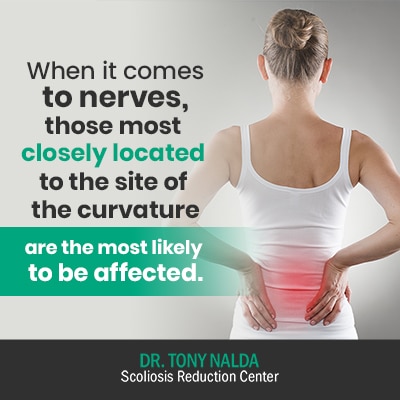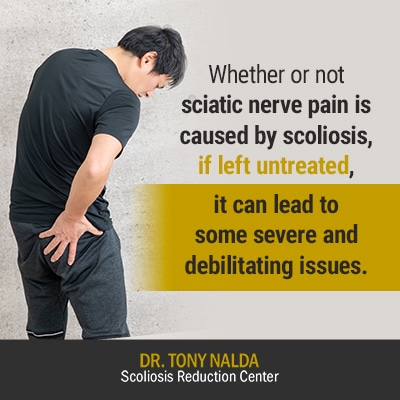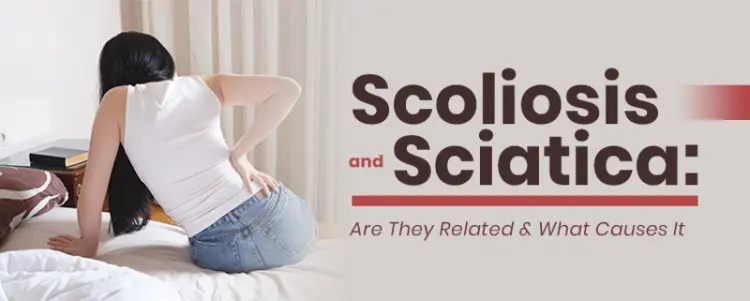Scoliosis can cause a host of issues that are felt throughout the body. Oftentimes, symptoms that seem unrelated to scoliosis are directly, or indirectly, linked. Scoliosis and sciatica are related not only because they can produce similar symptoms, but also because a scoliotic curve can put pressure on various points along the spine, including the sciatic nerve that starts in the lower back.
Scoliosis doesn’t just impact the spine, but also its surrounding muscles and nerves. The sciatic nerve starts in the lumbar spine and extends downwards to the feet. A scoliotic curve means the spine is misaligned and can put excess pressure on the sciatic nerve, causing pain and discomfort.
Before moving onto the connection between scoliosis and sciatica, let’s first take a look at what changes the spine is facing as scoliosis develops.
The Scoliotic Spine
The spine plays many important roles, giving the body structure and support and allowing us to stand upright. It also facilitates flexible movement and a healthy range of motion.
In addition, the spine is designed to protect the spinal cord that passes through the spinal canal. The spinal cord is a bundle of nerves that connects with the brain and facilitates communication throughout the body: the central nervous system (CNS). Because of the CNS, we are able to control the way our bodies move and respond to stimuli.
As a crucial aspect of the body’s central nervous system, if a spinal condition develops, it can produce a wide range of symptoms that can be felt throughout the body, and not just in, and directly around, the spine.
When a scoliotic curve is present, this means the spine has an abnormal curvature with rotation. A scoliotic curve can develop anywhere along the spine’s three main sections: cervical (neck), thoracic (middle and upper back), and lumbar (lower back).

When it comes to nerves, those most closely located to the site of the curvature are the most likely to be affected. In addition, scoliosis is progressive, meaning it’s going to get worse over time, especially if left untreated, so as a scoliotic curve increases in size, so too does the likelihood that it will produce more noticeable symptoms such as postural changes, pain (in adults), and nerve issues.
As scoliosis introduces adverse spinal tension, it can cause the pinching and constriction of the vertebrae (bones of the spine) and surrounding muscles, vessels, and nerves.
What is Sciatica?
As previously mentioned, the sciatic nerve starts in the lumbar spine and extends down the back of both legs, reaching near the heels of the feet.
When the sciatic nerve is pinched or exposed to adverse tension and pressure, sciatic pain can be felt along the sciatic nerve.
Before I explain the connection between scoliosis and sciatica, let’s talk about other causes of sciatic pain.
Causes of Sciatic Pain
While scoliosis is a common cause of sciatic pain, especially in adults, it can also have other causes such as a herniated disk that pinches the nerve, muscle swelling/inflammation, or a misaligned spine caused by another spinal condition.
Symptoms of sciatic nerve pain include lower-back pain and pain that radiates down both legs because these areas are where the sciatic nerve passes through. Every case is different based on both patient and condition characteristics, but sciatic nerve pain does have the reputation of being one of the most debilitating nerve-related back issues.
People who suffer from this type of nerve pain generally experience mobility issues that can impact overall quality of life and make even simple tasks more challenging.
Scoliosis and Sciatic Pain
As mentioned, scoliosis involves having a spine that has lost one or more of its healthy curvatures, and once those natural healthy curves are lost, they are replaced by unnatural curves. This introduces a lot of uneven forces to the spine and the rest of the body.
As a scoliotic curve progresses, it can squeeze the sciatic nerve, and this can lead to pain at the site and/or radiating pain down one leg, (rarely both legs), and can be felt right down to the tre feet.
Scoliosis, even if it doesn’t involve the sciatic nerve, can cause other nerve issues and radiating pain throughout the body. In fact, when it comes to scoliosis in adults, it’s most often pain felt in the legs and feet that brings them in to see me for a diagnosis.
Nerves are like branches on a tree that fan out in multiple directions, which is why where a person feels pain isn’t necessarily its site of origin. When a person’s sciatic nerve is pinched and/or compressed, the squeezing can produce varying levels of pain that can range from mild and occasional to chronic and debilitating.
To summarize, scoliosis and sciatica pain have a strong connection. Scoliosis causes the spine to curve at unnatural angles, and this can put a lot of extra pressure on different areas of the back. Especially common in lumbar scoliosis (lower back), which is where the sciatic nerve starts, the sciatic nerve is exposed to that pressure and can cause varying levels of pain and discomfort.
Age and Scoliosis-Related Sciatic Pain
Scoliosis can develop at any age, but when it comes to scoliosis-related sciatica pain, it’s more commonly associated with adult patients over the age of 30. This is because adults have reached skeletal maturity, meaning their spines have stopped growing and have settled due to maturity and gravity; with a spine that is no longer moving through growth, it’s more likely to rest on a nerve, such as the sciatic nerve, and cause pain.
That being said, adolescents, who happen to be the most common age group (10-18) diagnosed with scoliosis, can still experience scoliosis-related nerve pain if a growing spine pinches a nerve.
At this age, treatment is much simpler as their spines have not settled due to gravity, their bodies have yet to adjust to the curvature, and their spines have more flexibility and are more easily manipulated with conservative treatment: chiropractic care, in-office therapy, custom-prescribed home exercises, and specialized corrective bracing.
While more common in adults, adolescents can also experience a pinched sciatic nerve that occurs as scoliosis progresses, and pinched nerves are known to produce varying levels of pain and discomfort. The key to relief is through proactive treatment, such as the functional chiropractic-centered approach I offer patients here at the Scoliosis Reduction Center®.
Now, if a sciatic-nerve issue is left untreated, what can happen?
Sciatic Nerve Damage
While there are ways to relieve nerve pain by addressing the underlying cause of the nerve being pinched and/or compressed, if left untreated, especially when it’s scoliosis related, it can become more severe and damaging the nerve.
If the sciatic nerve is damaged, these are the areas of the body that are affected and the symptoms they develop:
Lower Back
Perhaps the most common symptom of sciatic nerve damage is pain in the lower back, and this can also be accompanied by tingling sensations and feelings of numbness.
These symptoms can start out mild but tend to progress over time; they are known to make bending forward particularly difficult.
The Feet
As the sciatic nerve extends down to the bottoms of the legs, the feet can also experience symptoms of sciatic nerve damage.
This symptom is one that often confuses people. If the structure of nerves are misunderstood, it’s easy to see how someone experiencing foot pain could naturally assume the cause originated in the feet, but that is not necessarily the case.
Varying levels of foot pain can develop because the sciatic nerve stretches throughout the lower body, so symptoms of its damage can also be felt throughout.
Upper Legs
Another very common symptom of sciatic nerve damage involves the upper section of the lower body, where the sciatic nerve originates.
People who experience a burning sensation in the lower back, upper legs, buttocks, and calves can be suffering from sciatic nerve damage.
Mobility Issues
In addition to pain, mobility issues can be the most concerning aspect of sciatic nerve damage because it can significantly impact a person’s ability to keep up with their daily tasks/responsibilities and their overall quality of life.
As the sciatic nerve mainly rests in the lower back, pain can be focused in the legs, causing mobility issues.

Whether or not sciatic nerve pain is caused by scoliosis, if left untreated, it can lead to some severe and debilitating issues. Fortunately, there are a number of ways that this can be avoided, in the form of proactive treatment.
As is the case with other scoliosis-related issues, and scoliosis itself, early detection and treatment increases the chances of delivering a successful outcome. If you are experiencing any of the aforementioned symptoms, be proactive and seek help from a medical professional before symptoms increase in severity and are harder to treat.
Proactive Treatment for Sciatic Nerve Damage
There are a variety of treatment options, both surgical and nonsurgical, available for those suffering from sciatic nerve damage. When related pain and symptoms are caused by scoliosis, it can often be treated nonsurgically.
The first step is to seek medical help so the underlying cause of the nerve damage can be determined. If it is scoliosis-related, a treatment plan can be designed and implemented as close to the time of diagnosis as possible; that way, we have the best chance of impacting the condition in a positive way.
While medication is a common aspect of treatment for sciatic nerve damage, as the pain can be significant, it’s important to keep in mind that this is not actual treatment. This is merely addressing a symptom of the issue, not the issue itself.
In addition, masking symptoms with pain medication can be potentially harmful by hiding the fact that symptoms are getting worse.
There is no medication that can address the underlying cause of scoliosis, or scoliosis-related nerve pain, because the cause is structural; thus treatment has to impact the condition on a structural level by correcting the misalignment of the spine.
Medication can help with relieving pain during treatment, but should never be viewed as treatment of its own.
Following are common treatments used to address scoliosis-related sciatic pain:
Focused Chiropractic Adjustments
Scoliosis-specific focused chiropractic adjustments are a common treatment for scoliosis. It can reduce tension and pressure on the sciatic nerve, relieving pain and discomfort.
As I work towards straightening the misaligned spine, the healthy curvatures return, reducing the uneven forces and adverse spinal tension caused by the condition.
This method is highly effective in addressing the underlying cause of the sciatic nerve damage because it is impacting the scoliosis, which is the cause of the nerve damage, on a structural level.
Exercises and Stretches
When exercises and stretches are scoliosis-specific, designed by a specialist, and customized to address the specifics of a condition, they can be a highly-effective form of treatment.
Once the specific exercises and stretches are taught properly to ensure they are being done safely and effectively, they can be done at home. This form of treatment, combined with chiropractic-specific scoliosis care and therapy, can actually work to reduce the curve.
Stretches and exercises also help keep the spine and its surrounding muscles as loose as possible so they are better able to support and stabilize the spine.
Again, as the spine straightens, the compression felt by its surrounding areas, including the sciatic nerve, is relieved.
Bracing
Back braces are another common form of treatment used to manage scoliosis progression and achieve a curvature reduction. However, not all back braces are created equal; some have managing progression as their treatment goal, which means they don’t actually correct the spinal misalignment, but focus on slowing/stopping progression.
Here at the Scoliosis Reduction Center®, I use the ultra-corrective ScoliBrace. This brace represents the culmination of what we have learned about scoliosis braces over the years, as well as the condition itself, and is customizable, more comfortable to wear, and has correction as its end goal.
As this type of brace is corrective, it has the potential to impact scoliosis on a structural level, addressing the underlying cause of the sciatic nerve issue as the scoliosis itself is improved.
Conclusion
As a progressive spinal condition, scoliosis should be treated proactively as soon as the condition is detected. This helps treatment in a number of ways; it means catching the condition at its mildest, before it has progressed, simpler treatment of a smaller curvature, and applying treatment before the body has adjusted to the abnormal curve.
Early detection and treatment increase the chances of treatment success and reducing/eliminating related symptoms, such as sciatica.
As scoliosis is a structural issue, treatment efficacy will depend upon whether or not it impacts the condition on a structural level. If the condition is caught early on and an effective treatment plan is designed, there are fewer limits to what we can accomplish.
Often, as a scoliotic curve is reduced, so too are its related symptoms and complications, such as sciatica. As it’s the crooked spine that exposes uneven pressure to areas of the back, as a misaligned spine becomes straighter, the adverse spinal tension is reduced, relieving the pressure on related muscles, tissue, and nerves.
As sciatic nerve damage can lead to pain in the lower back, legs, feet, and sensations of tingling and/or numbness, mobility issues can develop and reach debilitating levels, if left untreated.
If you are experiencing scoliosis and sciatica, the single best approach is a proactive treatment that impacts the scoliosis on a structural level and addresses related symptoms, such as sciatica.





